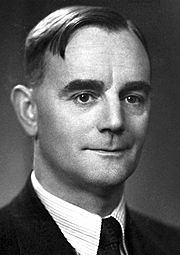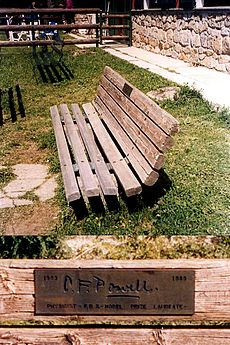C. F. Powell facts for kids
Quick facts for kids
C. F. Powell
|
|
|---|---|

Powell in 1950
|
|
| Born |
Cecil Frank Powell
5 December 1903 |
| Died | 9 August 1969 (aged 65) Rifugio Capanna Vittoria, Alpe Giumello, Casargo, Province of Lecco, Italy
|
| Nationality | English |
| Citizenship | British |
| Alma mater | University of Cambridge |
| Known for | Photographic method Discovery of the pion |
| Spouse(s) | Isobel Artner |
| Awards | Nobel Prize in Physics (1950) Hughes Medal (1949) Fellow of the Royal Society (1949) Royal Medal (1961) Lomonosov Gold Medal (1967) |
| Scientific career | |
| Fields | Physics |
| Institutions | University of Cambridge University of Bristol |
| Doctoral advisor | C. T. R. Wilson Ernest Rutherford |
| Doctoral students | MGK Menon Peter Fowler |
Cecil Frank Powell (born December 5, 1903 – died August 9, 1969) was a British physicist. He won the Nobel Prize in Physics for his important work. Powell led a team that created a special photographic method. This method helped them study tiny parts of atoms. Using this, they discovered a new subatomic particle called the pion.
Contents
Early Life and Education
Cecil Powell was born in Tonbridge, Kent, England. His father was a gunsmith, someone who makes or repairs guns. Cecil went to a local primary school. Later, he won a scholarship to the Judd School in Tonbridge.
After school, he studied at Sidney Sussex College, Cambridge. He finished his first degree in Natural Sciences in 1925. Then, he worked at the Cavendish Laboratory in Cambridge. There, he studied how tiny water droplets form. He earned his PhD in physics in 1929.
In 1932, Powell married Isobel Artner. They had two daughters, Jane and Annie.
A Career in Physics
In 1928, Powell started working at the University of Bristol. He became a research assistant and later a lecturer. In 1948, he became a professor of physics.
In 1936, he joined a trip to Montserrat in the West Indies. This trip was to study a series of damaging earthquakes. He even appeared on a stamp from Grenada!
Discovering New Particles
At Bristol University, Powell worked on new ways to measure tiny charged particles. He also built a special machine to study how atomic nuclei behave.
He started to develop a new method using special photographic plates. These plates could record the paths of very small particles. In 1938, he began using this method to study cosmic radiation. Cosmic radiation is made of high-energy particles from space.
Powell and his team took photographic plates to high places. They used mountain tops and special balloons. This work led to a huge discovery in 1947. They found the pion, also known as the pi-meson. This particle had been predicted by a scientist named Yukawa Hideki in 1935.
Awards and Recognition
In 1949, Cecil Powell became a member of the Royal Society. He also received the Hughes Medal that same year.
In 1950, he won the Nobel Prize for Physics. He received it for creating the photographic method and for discovering mesons with it. Other scientists, like Debendra Mohan Bose and Bibha Chowdhuri, had also worked on similar ideas earlier. Powell recognized their contributions in his book.
From 1952, Powell led several trips to Italy. They used high-altitude balloons to continue studying cosmic rays.
Working for Peace
Cecil Powell was also interested in using science for good. He was a member of the World Federation of Scientific Workers. In 1955, he signed the Russell-Einstein Manifesto. This was a call from scientists for peace and against nuclear weapons.
He also helped set up the first Pugwash Conferences on Science and World Affairs. These meetings brought scientists together to discuss global peace and nuclear disarmament. Powell was a very important part of the Pugwash Movement. He often led the meetings.
In 1961, Powell received the Royal Medal. In 1967, he was given the Lomonosov Gold Medal. This award was for his great work in the physics of elementary particles.
Death
Cecil Powell died on August 9, 1969. He was on holiday with his wife in Italy. He had a heart attack during a walk in the Alps.
His friend, Giuseppe Occhialini, had a wooden bench built in Powell's memory. It has his name carved on a plaque. The bench was placed on the path where Powell died. Occhialini said that if the bench had been there earlier, Powell might have stopped to rest.
Legacy
- The Cecil F. Powell Memorial Medal was named after him. It is given by the European Physical Society.
- In 2011, a new plaque was put up in Bristol to remember him.
- The Judd School, where he studied, named one of its houses after him. The school also gives a special prize in his honor every year.
- In 2013, a sign was put up in Italy near where he died, remembering his life.
See also
 In Spanish: Cecil Frank Powell para niños
In Spanish: Cecil Frank Powell para niños


